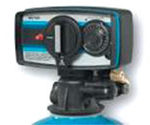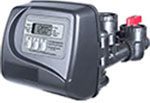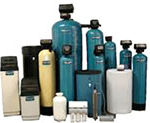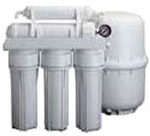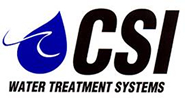FAQ
A water softener with an iron removal unit and a cartridge filter would help to soften the water and remove stain causing iron.
An acid neutralizer and a cartridge filter would remove stain causing acids and other minerals and sediments.
Hydrogen Sulfide (H2S)
Hydrogen Sulfide is a gas which smells strongly like rotten egg odor. It results from the decay of organic matter with organic sulfur and the presence of certain types of bacteria. Even very low concentrations are offensive as well as highly corrosive (silver tarnishes almost immediately upon contact with H2S).
Because it is in the form of a gas, H2S cannot be collected in a sample bottle for laboratory analysis. Therefore its presence must be reported when a sample is submitted for a treatment recommendation.
Solutions
There are three types of systems for water treatment, which can include an IronGate, an Airregen, or Entipur AirCycle Aeration system.
Due to the hydrological cycle, the process of how water vapor condenses in the atmosphere and falls back to earth as rain, about 30% of the rain does not evaporate. It seeps into the ground or runs off into streams, rivers, or lakes, dissolving minerals and other substances contained in the ground.
Earth?
70% of the earth's surface is water. Only 3% of it is drinkable.
Almost?
Almost 75% of an adults body is made up of water, which is critical for proper body organ function and regulating body temperature.
Coffee?
Caffeine, alcohol and smoking dehydrate your body.
Nationally?
Nationally, 86% of Americans expressed doubt over tap water quality. 66% raised concerns over smell and taste. 51% had concerns over health related contaminants.
Water?
Water is naturally low in sodium, contains no fat, caffeine or cholesterol, and isn't flushed out of the body like many other beverages.
Ground water will always have some substances dissolved in it.
It will always have the potential for suspended particles.
It will always have the potential to be a home for disease-causing organisms.
Iron removal systems?
Reduce iron manganese sediment and rust from all incoming water. These systems come in a variety of designs, including chemical free and a combination of iron removal/water softening systems.
Water softeners?
Reduce calcium, magnesium and other soluble metals which create scale build-up. Available in a variety of models and sizes, each is designed to fit your custom application.
Acid neutralizers, backwashing filters and aeration systems?
Reduce acid content, sediment and offensive odors from all incoming water. These systems come in a variety of capacities each designed to meet your specific water needs.
Ultra-Violet sterilizer systems?
UV systems treat water without adding chemicals without changing the taste or odor of the water, and without removing the beneficial minerals in the water. These systems come in a variety of sizes and accommodations.
Drinking water systems?
Reduce sediment, chlorine, lead, VOC's and MBTE. These systems are designed for point of uses, and come in a wide variety of sizes and configration, including reverse osmosis to meet your specific water needs and deliver clean, great tasting water.
Whole house Filters?
Reduce sediment, rust and chlorine taste from all incoming water. With an easy to replace cartridge, these filters can help extend the life of fixtures and water based appliances.
Water Filtration Systems uses cuno Aqua-Pure filtration products.Aqua-Pure products provide a full range of solutions for all your water treatment problems.Aqua-Pure products come in multiple sizes and configurations,each with different levels of performance options designed to meet your needs and budget. Make an appointment and we can determine the right choice for you!
What is Radon?
Radon is a colorless, odorless, tasteless, radioactive gas. Radon is the natural radioactive breakdown of uranium in the ground. Radon in water is found in nearly all sources of surface water and groundwater. It is created by the radioactive decay of radium, a naturally occurring radioactive element found in underground rock formations, particularly granite and quartz. Water that flows through or over radium rich rock formations accumulate radium and thus radon from the decay process. Typically, groundwater has much higher levels of radon than surface water. This is because radon in groundwater is “trapped” by being submerged underground and cannot easily escape. Because of this fact, water supplies from underground wells have a much higher probability of having significant levels of radon. If you get your drinking water from a surface water source, radon in water probably is not a significant health hazard. Large, pretreated municipal water supplies typically have negligible levels of radon in water because usually this type of water supply is drawn from surface water sources, and because water treatment tends to reduce radon levels even further.
Health Risks:
Radon exposed in water or air can lead to risks of developing organ & lung Cancer. The Surgeon General has warned that radon is the second leading cause of lung cancer in the United States. Radon in drinking water is a significant health hazard, though a lesser hazard than radon air. However, we can fix both. If you suspect there may be Radon in your water supply, we recommend getting your water tested.
How Radon water is corrected:
Aeration units are typically used to remove gases from water. The most common gases are radon, hydrogen sulfide (rotten egg odor) and carbon dioxide (a Bubble-Up® unit from R.E. Prescott Co.cid water). Aeration can be accomplished via air pumps, well line venturi-mirconizer, or bubbling the water in an atmospheric chamber. We offer all of the methods, but for the best results the diffused bubble aeration process is the most effective. Aeration is a process in which air and water are brought into intimate contact. Turbulence increases the aeration and the water flow is usually directed counter current to atmospheric or forced-draft air flow. The contact time and the ratio of air to water must be sufficient for effective removal of the unwanted gas.
Uranium is a naturally occurring element that is found in rocks. Not all rocks contain Uranium, however, there are some places in Maine that are exposed to Uranium. Uranium breaks down very slowly into other elements including radium and radon gas.
Health Risks
The dangers of drinking water high in uranium can harm your kidneys. Kidneys filter your blood and make urine. Uranium can also cause liver damage and cancer and its chance of happening, depends on:
Levels of Uranuim found in your water
The amount of tap water you consume
The length of time you have been consuming the water
Bathing and showering is not a health concern as Uranium is not absorbed through the skin. If you suspect that Uranium may be in your water supply, we recommend getting your water tested.
How Uranium is corrected:
Correction treatment systems can vary between Reverse Osmosis or Mixed Bed Softener. We prefer to use the Mixed Bed Softener for whole house systems. The Mixed Bed Softener costs 75% less than a Reverse Osmosis and requires less maintenance with the same results.
Quick Short-term Solution: Drink bottled water if your test results are high. If you often cook foods that soak up or use water like noodles, rice, and soup, use bottled water. You can either keep using bottled water, or choose a treatment system to remove the uranium.
Some common solutions include: Reverse Osmosis or Ion Exchange water treatment systems.
For more information, contact Water Filtration Services.
Hardness
Calcium (Ca)
Magnesium (Mg)
The term hardness refers to the quantity of dissolved calcium and magnesium in water. These minerals, which come primarily from limestone type rock formations, are found to some degree in almost all natural waters. Calcium and magnesium cause problems for two principal reasons:
When the water is warmed, they precipitate out of solution and form a hard, rock-like scale. This scale accelerates corrosion, restricts flow, and reduces heat transfer in water heaters and boilers.
When they combine with soap, they react to form a curd, which interferes with cleaning, dries out skin, and leaves deposits on plumbing and clothes (bathtub ring; ring around the collar).
Hardness is measured in parts per million (or the equivalent mg/L) or in grains per gallon (gpg). Note: if the water analysis is given in ppm as CaCO3 then 1 gpg = 17.1 ppm. A common aspirin tablet weighs 5 grains). There is no established limit for the acceptable level of hardness in water, but it is generally considered to start to become problematic at around 3 gpg.
Levels of hardness are referred to as follows:
Soft Water………………………….. 0-1 grains per gallon (gpg)
Slightly Hard Water………………. 1-3.5 gpg
Moderately Hard Water………… 3.5-7 gpg
Hard Water…………………………. 7-10.5 gpg
Very Hard Water………………….. over 10.5 gpg
Waters which naturally contain very little hardness can also be problematic because they may be corrosive.
*Water Softeners
A water softener works on the principle called “cation exchange,” in which ions of mainly hardness but also iron and manganese are exchanged for sodium or potassium ions, reducing their concentrations to insignificant levels. The exchange occurs with in a tank using tiny synthetic resin beads made from a special plastic.
After a period of use, the sodium or potassium ions are completely exchanged and the unit has to be “backwashed” or “regenerated.” This requires the use of sodium or potassium chloride, which is loaded into a “brine tank” and dissolved to form a brine solution used to recharge the resin beads.
Iron (Fe)
The presence of Iron is a very common water quality problem, particularly in water from deep wells. Water containing even a significant quantity of iron may appear clear when drawn, but will rapidly turn red upon exposure to air. This process is called oxidation, and involves the conversion of ferrous (dissolved) iron, which is highly soluble, to ferric (precipitated) iron, which is largely insoluble. The ferric iron then causes red/brown staining on clothes, fixtures, etc.
Iron concentration is measured in ppm or mg/l (milligrams per liter, where 1 ppm = 1 mg/l). Staining usually becomes a problem at concentration greater than 0.3 ppm.
Manganese is a metal similar to iron which causes grey/black staining. It can cause staining in concentrations as low as 0.05 ppm. Manganese is removed in a manner similar to iron, although oxidation is more difficult, requiring a pH of at least 8.5.
Natural sources of manganese are more common in deeper wells where the water has been in contact with rock for a longer time. Manganese are readily apparent in drinking water supplies, causing a strong metallic taste to the water and causing staining. Water coming from wells and springs with high manganese may appear colorless initially but black (manganese) stains or particles quickly appear as the water is exposed to oxygen.
What is PH?
Water with high pH indicates there is a high level of alkalinity minerals; this can cause build-up in plumbing and lower efficiency of electric water heaters.pH is a contaminant that is considered acidic, water with low pH can be acidic, naturally soft and corrosive. Low pH can damage your pipes and fixtures which causes a sour or metallic taste. Over time staining will appear in sinks, drains, and in laundry. Without proper treatment, over time the acidic water deteriorates your copper pipes creating tiny pin holes.
Correction for low pH:
Acid Neutralizer
Calcite is a naturally occurring calcium carbonate material that is relatively inexpensive and can be used to neutralize acidic or low pH waters. When properly applied, it corrects pH only enough to reach a non-corrosive equilibrium. Upon contact with Calcite, acidic waters slowly dissolve the calcium carbonate to raise the pH which reduces the potential leaching of copper, lead and other metals found in typical plumbing systems. Periodic backwashing will prevent packing, reclassify the bed and maintain high services rates. Depending on pH, water chemistry and service flow, the Calcite bed will have to be periodically replenished as the Calcite is depleted. As the Calcite’s calcium carbonate neutralizes the water, it will increase hardness and a Water Softener may become necessary after the neutralizing filter.
Arsenic is odorless, colorless and tasteless, so you cannot see it, smell it or detect it by drinking water. Arsenic can enter drinking water through the ground or as a run off into surface water sources.Heating or boiling will NOT remove arsenic, arsenic concentrations can actually increase slightly as the water is boiled.
Health Risks:
Long term exposure to Arsenic has been linked to skin damage, problems with the circulatory system, and an increase risk of getting different types cancer. Arsenic and other heavy metals have been linked to numerous health issues, but fortunately there are solutions available to reduce, or remove, heavy metals from your drinking water. If you suspect there may be Arsenic in your water supply, we recommend getting your water tested.
Treatment:
GreenPro Point of Use (POU)
We offer a GreenPro 6×18 Point of Use system, which corrects only the cold water at the kitchen sink. The heart of the GreenPro Point of use system is an advanced NSF/ANSI 61- Certified and approved by hydrous iron oxide impregnated resin. The resin efficiently and safely binds arsenic and never needs backwashing.
System Advantages:
Convenient 6”x18” Columns
No connection to sewer or septic required
System is always in service
No wasted water
Simple and reliable hardware
No arsenic-laden waste is released at home
The GreenPro POU System, with LayneRT resin will reliably and efficiently reduce arsenic to a safe consumption level. This system is a comprehensive solution, which comes with a testing program of 4 water tests at 6 months intervals, and an exchange tank disposal program once the media is exhausted, to reduce your arsenic concerns. The GreenPro POU System treats the entire cold-water flow so that no additional faucet is required. The 2 GPM system provides arsenic protection, with minimal interference in your Kitchen.
GreenPro Point of Entry (POE)
We offer a GreenPro Point of Entry system, which corrects all water entering the home. The heart of the GreenPro POE system is an advanced NSF/ANSI 61- certified and approved hydrous iron oxide impregnated resin. The resin efficiently and safely binds arsenic and never needs backwashing.
System Advantages:
No connection to sewer or septic required.
System is always in service
No wasted water
The hardware is simple and reliable
No arsenic-laden waste is released at home
Models with flow rates ranging from 0-15 GPM
The GreenPro Point of Entry water system, with LayneRT Resin will reliably and efficiently reduce arsenic to a safe consumption level. The GreenPro POE system is a total comprehensive solution, which comes with a testing program of 4 water tests at 6 month intervals, and an exchange tank disposal program once the media is exhausted, to reduce your arsenic concerns. The GreenPro POE is a whole house program-all the water in your house is treated-not just one faucet. With the GreenPro POE, you can drink from any tap, water your garden, swim in your pool, or take a shower without worrying about arsenic exposure.
npXtra Point of Entry
We offer a npXtra of Entry system, which corrects all water entering the home. The heart of the npXtra Point of Entry system is advanced NSF/ANSI 61- Certified and approved hydrous iron oxide impregnated resin. The resin efficiently and safely binds arsenic and never needs backwashing.
System Advantages:
No connection to sewer or septic required.
System is always in service
No wasted water
The hardware is simple and reliable
No Arsenic-laden waste is released at home
Models with flow rates ranging from 0-15 GPM
The npXtra Point of Entry Systemwith LayneRT media will reliably and efficiently reduce arsenic to a safe consumption level. This system comes with two tanks. The npXtra system is a total comprehensive solution, which comes with a testing program of 3 water tests at 6, 15 and 24 month intervals, and an exchange tank disposal program once the media is exhausted, to reduce your arsenic concerns.The npXtra POE is a whole house program-all the water in your house is treated-not just one faucet. With the GreenPro POE, you can drink from any tap, water your garden, swim in your pool, or take a shower without worrying about arsenic exposure.

